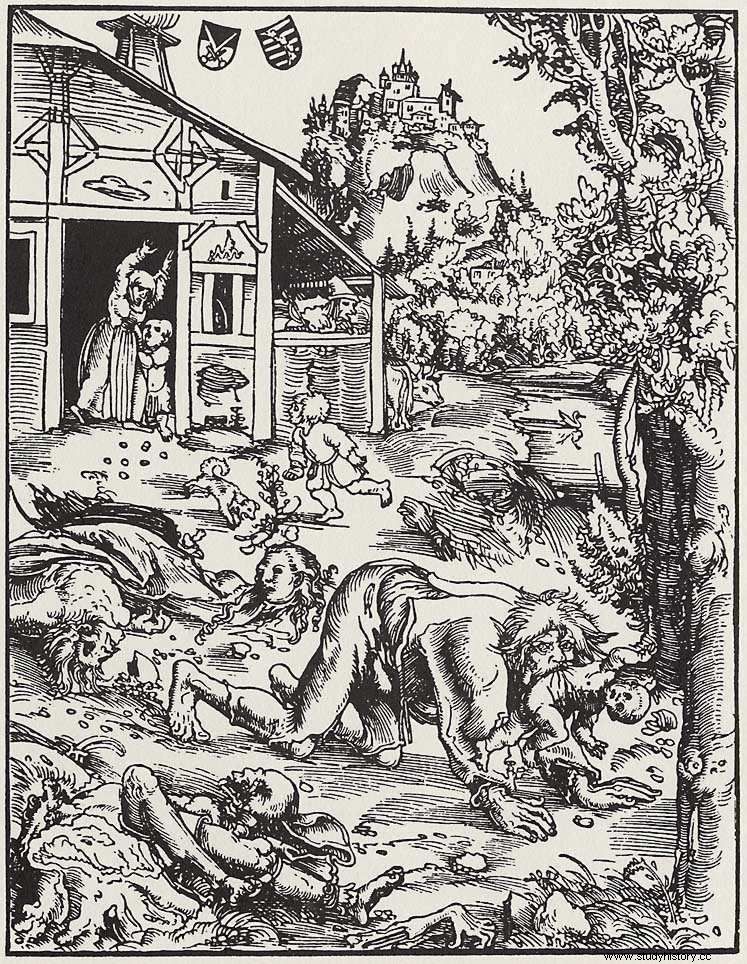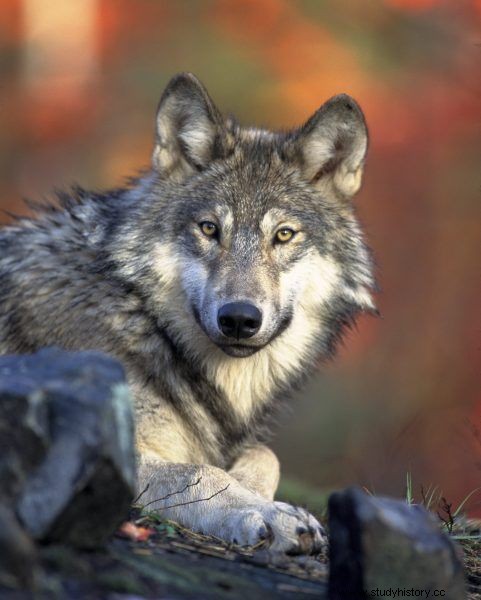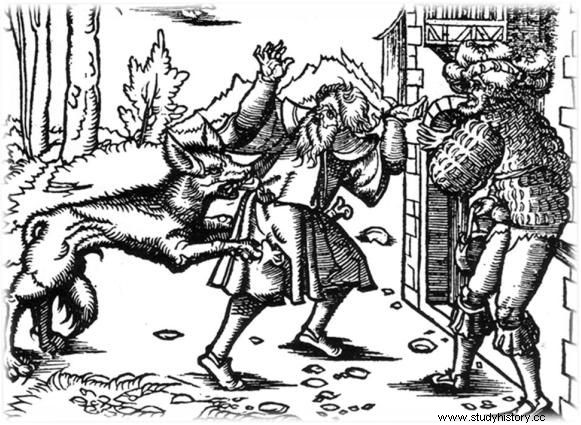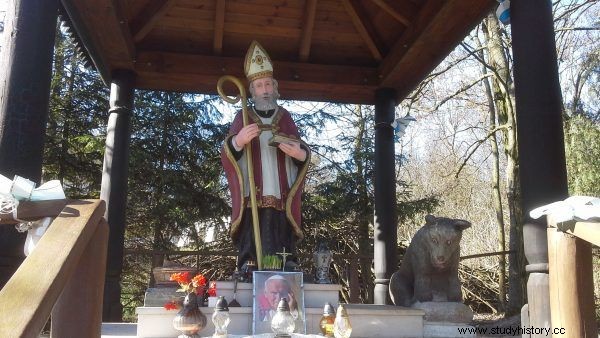Werewolves are one of the most popular mythical creatures present in contemporary pop culture. Examples include the saga "The Witcher" by Andrzej Sapkowski, "Silmarillion" by J. R. R. Tolkien, as well as horror classics such as "Werewolf" or "Wolf". Do the mythical beasts have a Slavic origin? And what does ... St. Santa?
The wolf - as one of the main European predators - from ancient times aroused in people both fear and admiration. He was often a symbol of evil and cunning, but also of strength, bravery and bravery. Hence, it was present in many beliefs, and the conviction about the existence of people transforming into wolves is known, among others, by from Greek, Celtic, Germanic and finally Slavic mythology.
Slavic origin of werewolves?
The oldest mention of werewolf among the Slavic peoples is considered to be the description of the Neur by Herodotus. Neuros, living in the area northwest of the Black Sea, considered by some researchers to be the ancestors of the Slavs, had to turn into wolves for several days once a year .
However, the records of werewolves from the territory of Poland date back to the 16th century. That is why some researchers recognize that this belief appeared in our country only then. Regardless of whether it was "indigenously" Slavic or not, it was very widespread in the modern period. The very word "werewolf" comes from the words:"wolf" and "dłaka" - hair. There are three types of werewolf :the first was the ability to turn certain people into wolves of their own accord; the second - the ability to turn other people into wolves (e.g. by casting a spell on them); and finally the third - the transformation of the repentant soul of a deceased into a wolf.

Werewolf, Lucas Cranach the Elder, 1512
In the 16th century, a strange-looking man was captured in Masuria - his body was densely hairy and his face had a wild expression. Apparently he claimed to be a werewolf himself. He was to turn into a wolf twice a year:at Christmas and on St. John's Day. To verify his testimony, he was kept under guard for some time. However, the expected transformation into a wolf did not take place.
Sorcerer in the form of a wolf
The people who could turn into wolves were usually witches or witches. However, such a transformation took place after performing a specific ritual. In Podlasie, for example, there was a story of a witch who could turn into a wolf . However, to do this, she had to find seven trees with magical powers in the forest. Each of them went around seven times, gradually taking the form of animals. Then, as a wolf, she was supposed to chew on horses, cows, sheep and pigs . Once, however, during the transformation, she was discovered by a gamekeeper. As she started to run away, he shot her. After her death, the witch's body was human again.
On the other hand, in White Russia, a sorcerer, in order to turn into a wolf, had to fall three times through a knife stuck in the ground, while casting an appropriate spell. Then, in the form of a great wolf with four eyes, he attacked people . To return to human form, he had to fall over the same knife again. But if someone took the knife out in the meantime, the sorcerer would remain a wolf forever. Another way, known from Ukraine, was to climb up the trunk of a chopped tree and roll it over to the ground. In turn, the Hutsuls believed that werewolves had a pit under their armpits, where the skin of wolves and human skin converged . During the transformation, the wolf's fur comes out on top and the human hides inside.

Gray Wolf
Not only sorcerers could turn into wolves. Ordinary people have sometimes done it, even unconsciously . This happened when there was a mistake in the baptism ceremony, as a result of which the man had a "pagan soul." It could also be a person with two souls, as with the phantoms. Then the second soul was called a "wolf" soul. Such a man turned into a werewolf without realizing it.
Turned into werewolves
The second type of werewolves were people turned into wolves by sorcerers, witches, or sheep (often using magic). The stories about wedding guests turned into wolves are especially numerous. In Podlasie, there were stories about a boy who courted the quack's daughter, but then he left her and married a richer girl. The would-be mother-in-law turned the boy into a wolf out of revenge. His family finally forced her to disenchant him. There were many stories about the behavior of people transformed into wolves under the influence of spell - according to some, they were usually mild (unlike the souls repenting in the form of wolves), they tried to get closer to human settlements without hurting anyone. In turn, others said that these creatures are more predatory than ordinary wolves - they attack people and cattle, dig up freshly buried corpses, kidnap children.
Kazimierz Władysław Wójcicki wrote a story about a farmer turned into a wolf by a witch for seven years, around the middle of the 19th century. After this time, he returned to his old home, but he was no longer welcome there:
His former farmhand, now the housewife's husband, ran out of the hut with pitchforks. Struck by this misfortune, he cried out of the air:"Why am I no longer a werewolf!" And at that moment he was transformed again, and in a wolf shape he devoured the hostess's child from the second marriage, biting her to death. The peasants fled to the scream of murder and, having slaughtered the wolf, saw the host's corpse, lost seven years ago ...
As this account shows, a man once turned into a wolf could become one again, here even at his own request. The weapon used by the former farmhand against the werewolf is not accidental. It turns out that ordinary pitchforks were the best way to fight this creature. In Bialy Rus it was believed that it was enough to throw a pitchfork at a werewolf to make it assume a human form.

In some beliefs, souls did penance as wolves
Turning into a wolf could also be a punishment for sins. In some folk tales, St. Nicholas (as the patron saint of wolves) or Jesus himself. A story written in Sukowo near Kielce comes from the end of the 19th century:
When the Lord Jesus was walking around the world with Saint Peter and was interviewing how people were doing it, he heard that there are many greedy people who take away other people's belongings and like to eat only meat, so he turned them into werewolves as a punishment. At first, these werewolves, as a memento that they came from humans, walked on two hind legs, keeping their gait straight (...). When the Lord Jesus appeared to people after his resurrection, he turned the werewolves (...) into real wolves.
Souls repenting as wolves
The last type of transformation of a man into a wolf was his posthumous transformation, which was also a punishment for sins. The penitent souls in the form of wolves were to be distinguished from other wolves by a larger size and larger head . It also happened that they had two pairs of eyes, and sometimes they spoke with a human voice. They were especially dangerous to people. In Podlasie, stories were told of a robber who was turned into a wolf after murdering a clergyman. In this form he also attacked people and bit them to death . Hunters are especially fond of them. When they tried to shoot the wolf, the bullets bounced off it. Eventually, he was shot with a blessed bullet.
Santa Claus… from the wolves
According to folk beliefs, the power over wolves was exercised by Saint Nicholas. He could defend the attacked against wolves or werewolves, as well as disenchant people turned into wolves. The proverbs used to say:"In the name of Saint Nicholas, the wolves of a group are ravaged," or "Santa Claus locks their mouths with padlocks." The relationship of the cult of St. Nicholas with wolves can still be seen today on the example of the chapel in Kryłów-Kolonia near Hrubieszów. In the chapel there is a figure of St. Nicholas and the accompanying wolf. According to one of the legends about the construction of the chapel, it was erected as a token of gratitude by a local heir who escaped the wolves' attacks on the horses carrying his sleigh.

Santa Claus with a wolf from a shrine in Kryłów-Kolonia
In Ruthenian legends, the power over wolves is exercised by St. Jerzy, and in the South Slavs - "wolf shepherd", a grandfather dressed in a wolfskin.
Isn't a werewolf so scary?
Werewolves, although in many stories they threatened people, were also often depicted as unfortunates, transformed into an animal by an evil sorcerer or witch. In some stories, a werewolf who had managed to revert to human form would come home after years of wandering in the woods to tell his loved ones about his fate. But then he turned into a wolf again and went back to the forest. Such an ambivalent status of werewolves was also presented in the "The Witcher" saga, for example in "The Time of Contempt" The Witcher felt sorry for the werewolf, who, driven into a cave, did not even defend himself, waiting only for the sword's blow. In "Season of Storms", the werewolf Dussart helps the Witcher in finding the hideout of the wizard Degerlund.
The werewolf motif belongs to a wider circle of beliefs related to the transformation of man into an animal, usually predatory, which were widespread practically all over the world. In Polish folk culture, it was intertwined with the Christian faith. However, it can be assumed that it comes from much older threads of belief.
